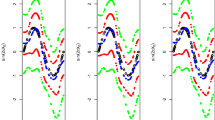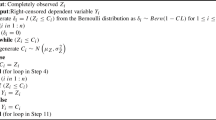Abstract
This study aims at regression analysis for quantile functions where the quantile regression coefficients are treated as functions over a continuum of quantile levels. We propose a general inference procedure for quantile regression coefficient functions with interval-censored outcome data. The modeling framework follows a recent proposal using a set of parametric basis functions to approximate the quantile regression coefficient functions. The new proposal can accommodate outcome data subject to general types of interval censoring, including fixed, random, and partly interval censoring. The large sample theory for the proposed estimator is established for inference, and a goodness-of-fit testing procedure is developed to guide the choice of the basis functions. We apply the proposed methodology to a survey dataset on monthly salaries of Taiwan workers, where only parts of the salary data are exact while the others are interval-censored according to the salary intervals prespecified in the survey questionnaire.


Similar content being viewed by others
References
Frumento, P., & Bottai, M. (2016). Parametric modeling of quantile regression coefficient functions. Biometrics, 72, 74–84.
Frumento, P., & Bottai, M. (2017). Parametric modeling of quantile regression coefficient functions with censored and truncated data. Biometrics, 73, 1179–1188.
Frydman, H. (1994). A note on nonparametric estimation of the distribution function from interval-censored and truncated observations. Journal of the Royal Statistical Society, Series B, 56, 71–74.
Kim, Y.-J., Cho, H., Kim, J., & Jhun, M. (2010). Median regression model with interval censored data. Biometrical Journal, 52, 201–208.
Koenker, R. (2005). Quantile Regression. Cambridge University Press.
Koenker, R., & Bassett, G. (1978). Regression quantiles. Econometrica, 46, 33–50.
Newey, W. K., & McFadden, D. L. (1994). Large sample estimation and hypothesis testing. In R. F. Engle & D. L. McFadden (Eds.), Handbook of Econometrics (Vol. 4, pp. 2113–2148). Elsevier.
Ruder, S. (2016). An overview of gradient descent optimization algorithms. arXiv preprint. arXiv:1609.04747.
Shen, P. S. (2013). Median regression model with left truncated and interval-censored data. The Journal of the Korean Statistical Society, 42, 469–479.
Shen, P. S. (2020). Quantile regression for doubly truncated data. Statistics, 54, 649–666.
Sun, J. (2006). The statistical analysis of interval-censored failure time data. Springer.
Turnbull, B. W. (1976). The empirical distribution function with arbitrarily grouped, censored and truncated data. Journal of the Royal Statistical Society, Series B, 38, 290–295.
Zhang, Z., & Sun, J. (2010). Interval censoring. Statistical Methods in Medical Research, 19, 53–70.
Zhou, X., Feng, Y., & Du, X. (2017). Quantile regression for interval censored data. Communications in Statistics-Theory and Methods, 46, 3848–3863.
Author information
Authors and Affiliations
Corresponding author
Additional information
Publisher's Note
Springer Nature remains neutral with regard to jurisdictional claims in published maps and institutional affiliations.
Supplementary Information
Below is the link to the electronic supplementary material.
Appendix
Appendix
1.1 Derivation of Equation (2.2)
Since \(\tau _{y_i}=\{\tau :\,Q(\tau ;{\varvec{x}}_i)={\varvec{x}}_i^{\mathrm{T}}{\varvec{\beta }}(\tau )=y_i\}\) is assumed to be unique and \(Q(\tau ;{\varvec{x}}_i)\) is a monotone function of \(\tau \), we have \(I(y_i\le {\varvec{x}}_i^{\mathrm{T}}{\varvec{\beta }}(\tau )<\infty )=I(\tau _{y_i}\le \tau \le 1)\). Then,
1.2 Proof of \(E\{{{\tilde{e}}}_i(\tau )\}=\tau \)
It is sufficient to prove that \(E\{e_i(\tau )\}=\tau \). For ease of presentation, we remove the subscript i of \(c_{i1},c_{i2}\) and \({\varvec{x}}_i\), and write \(F_Y\) short for \(F_{Y|{\varvec{x}}}\).
By integration by parts,
and
It follows from (7.1) – (7.3), together with
that we prove \(E\{e_i(\tau )\}=\tau \).
Rights and permissions
About this article
Cite this article
Hsu, CY., Wen, CC. & Chen, YH. Quantile function regression analysis for interval censored data, with application to salary survey data. Jpn J Stat Data Sci 4, 999–1018 (2021). https://doi.org/10.1007/s42081-021-00113-3
Received:
Accepted:
Published:
Issue Date:
DOI: https://doi.org/10.1007/s42081-021-00113-3




